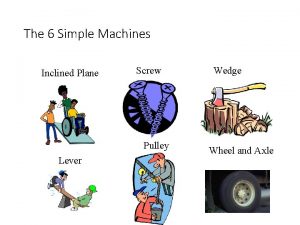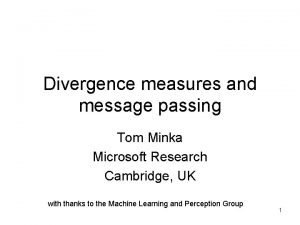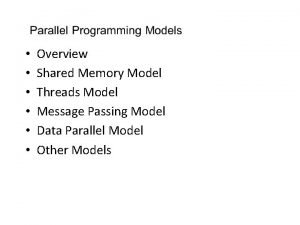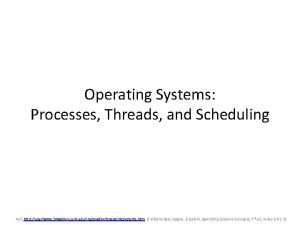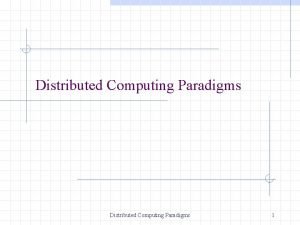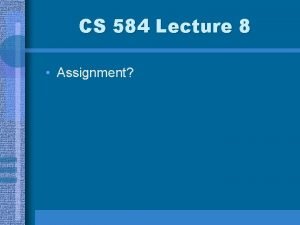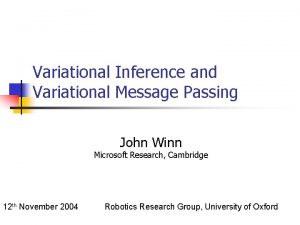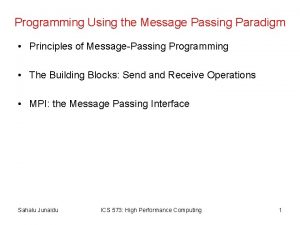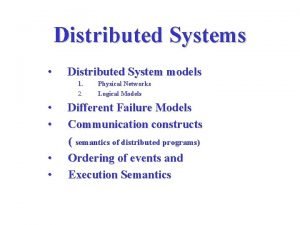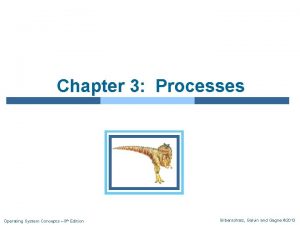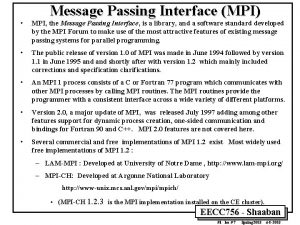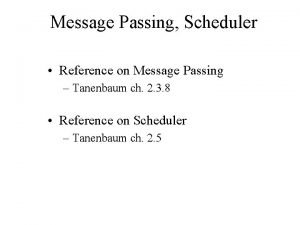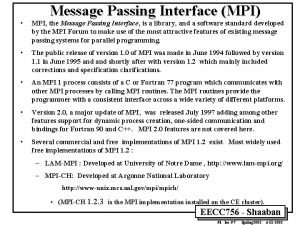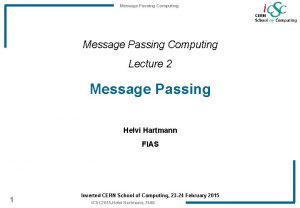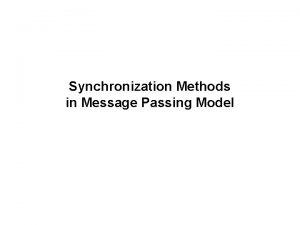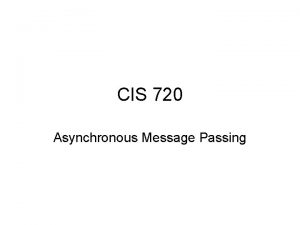Parallel Sparse LU Factorization on Secondclass Message Passing














- Slides: 14

Parallel Sparse LU Factorization on Second-class Message Passing Platforms Kai Shen University of Rochester 6/22/2005 ICS'2005 1

Preliminary: Parallel Sparse LU Factorization n n LU factorization with partial pivoting: used for solving a linear system Ax = b (PA=LU). Applications: n n n Device/circuit simulation, fluid dynamics, . . . … In the Newton’s method for solving non-linear systems Challenges for parallel sparse LU factorization: n n Runtime data structure variation Non-uniform computation/communication patterns ⇒ Irregular 6/22/2005 ICS'2005 2

Existing Solvers and Their Portability n Shared memory solvers: n n Message passing solvers: n n S+ [Shen et al. 2000], MUMPS [Amestoy et al. 2001], Super. LU_DIST [Li & Demmel 2004] Existing message passing solvers are portable, but perform poorly on platforms with slow message passing n n Super. LU [Li, Demmel et al. 1999], WSMP [Gupta 2000], PARDISO [Schenk & Gärtner 2004] Mostly designed for parallel computers with fast interconnect Performance portability is desirable n Large variation in the characteristics of available platforms 6/22/2005 ICS'2005 3

Example Message Passing Platforms n Three platforms running MPI n n Regatta-shmem, Regatta-TCP/IP, PC cluster Per-CPU peak BLAS-3 performance is 971 MFLOPS on Regatta and 1382 MFLOPS on a PC 6/22/2005 ICS'2005 4

Parallel Sparse LU Factorization on the Three Platforms Performance of S+ [Shen et al. 2000] n We investigate communication reduction techniques to improve the performance on platforms with slow comm. 6/22/2005 ICS'2005 5

Data Structure and Computation Steps Row block K for each column block K (1→N) Perform Factor(K); Perform Swap. Scale(K); Perform Update(K); endfor Processor mapping: Column block K 6/22/2005 n n ICS'2005 1 -D cyclic 2 -D cyclic (more scalable) 6

Large Diagonal Batch Pivoting n Large diagonal batch pivoting n n n may be numerically unstable n n Batch pivoting to reduce comm. 6/22/2005 Locate the largest elements for all columns in a block using one round of communication Use them as pivoting elements We check the error and fall back to original pivoting if necessary Previous approaches [Duff and Koster 1999, 2001; Li & Demmel 2004] use it in iterative methods ICS'2005 7

Speculative Batch Pivoting n Large diagonal batch pivoting fails the numerical stability test frequently n Speculative batch pivoting n n Collect candidate pivot rows (for all columns in a block) at one processor using one gather communication Perform factorization at that processor to determine the pivots Error checking and fall back to original pivoting if necessary Both batch pivoting strategies n n Require additional computation May slightly weaken the numerical stability 6/22/2005 ICS'2005 8

Performance on Regatta-shmem n n LD – large diagonal; SBP – speculative batch pivoting TP – threshold pivoting [Duff et al. 1986] Virtually no performance benefits 6/22/2005 ICS'2005 9

Performance on Platforms with Slower Message Passing PC cluster: n Improvement of SBP is 28 -292% for a set of 8 test matrices Regatta-TCP/IP: n The improvement is up to 48% 6/22/2005 ICS'2005 10

Application Adaptation n Communication-reduction techniques n n n Effective on platforms with relatively slow message passing Ineffective on first-class platforms n their by-products (e. g. , additional computation) may not be worthwhile Sampling-based adaptation n n Collect application statistics in sampling phase Coupled with platform characteristics, to adaptively determine whether candidate techniques should be employed 6/22/2005 ICS'2005 11

Adaptation on Regatta-shmem The “Adaptive” version: n Disables the comm-reduction techniques for most matrices n Achieves similar numerical stability as the “Original” version 6/22/2005 ICS'2005 12

Adaptation on the PC Cluster The “Adaptive” version: n Employs the comm-reduction techniques for all matrices n Performs close to the TP+SBP version 6/22/2005 ICS'2005 13

Conclusion n Contributions: n n n Propose communication-reduction techniques to improve the LU factorization performance on platforms with relatively slow message passing Runtime sampling-based adaptation to automatically choose the appropriate version of the application http: //www. cs. rochester. edu/~kshen/research/s+/ 6/22/2005 ICS'2005 14
 Inclined plane pyramids
Inclined plane pyramids Desirable features of a good message passing system
Desirable features of a good message passing system Message passing game
Message passing game Divergence measures and message passing
Divergence measures and message passing Shared memory linux
Shared memory linux Functional message
Functional message Message passing model
Message passing model Message passing system
Message passing system Object space paradigm
Object space paradigm Message passing interface
Message passing interface Variational message passing
Variational message passing Principles of message passing programming
Principles of message passing programming Message passing system in distributed system
Message passing system in distributed system Message passing
Message passing Message passing os
Message passing os
